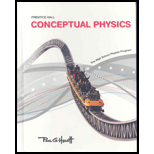
Concept explainers
To Explain: Whether a person gets younger by travelling at speed near the
Explanation of Solution
Introduction:
Twin paradox is the famous example in special theory of relativity. According Einstein’s Special Theory of Relativity, the time observed by the different observer depends on observer’s velocity. Time is not absolute according to
Where,
T = Time measured when person is in motion seen by the observer.
v = Velocity of the person with respect to ground observer.
c = Speed of the light.
Two synchronized clocks put together, one clock is sent with person to travel through space with speed comparable to the speed of the light and another clock is placed on the earth which is stationary. When the person returns from the space journey and time is measured in both the clocks, time measured by the person in spaceship and that of the stationary observer on the earth is different. The time shown by the clock travelled in the space is small as compared to the time shown by the clock which is stationary on the earth. By the same analogy, if a person measures his age before and after the space journey, he finds his age is less as compared to the age measured by the stationary observer on the earth.
Conclusion:
Therefore, relative to stationary person on the earth, person seems younger if he/she travels at the speed near the speed of light.
Chapter 15 Solutions
Conceptual Physics: The High School Physics Program
Additional Science Textbook Solutions
College Physics
Applied Physics (11th Edition)
Physics for Scientists and Engineers with Modern Physics
The Cosmic Perspective
An Introduction to Thermal Physics
Essential University Physics (3rd Edition)
 College PhysicsPhysicsISBN:9781305952300Author:Raymond A. Serway, Chris VuillePublisher:Cengage Learning
College PhysicsPhysicsISBN:9781305952300Author:Raymond A. Serway, Chris VuillePublisher:Cengage Learning University Physics (14th Edition)PhysicsISBN:9780133969290Author:Hugh D. Young, Roger A. FreedmanPublisher:PEARSON
University Physics (14th Edition)PhysicsISBN:9780133969290Author:Hugh D. Young, Roger A. FreedmanPublisher:PEARSON Introduction To Quantum MechanicsPhysicsISBN:9781107189638Author:Griffiths, David J., Schroeter, Darrell F.Publisher:Cambridge University Press
Introduction To Quantum MechanicsPhysicsISBN:9781107189638Author:Griffiths, David J., Schroeter, Darrell F.Publisher:Cambridge University Press Physics for Scientists and EngineersPhysicsISBN:9781337553278Author:Raymond A. Serway, John W. JewettPublisher:Cengage Learning
Physics for Scientists and EngineersPhysicsISBN:9781337553278Author:Raymond A. Serway, John W. JewettPublisher:Cengage Learning Lecture- Tutorials for Introductory AstronomyPhysicsISBN:9780321820464Author:Edward E. Prather, Tim P. Slater, Jeff P. Adams, Gina BrissendenPublisher:Addison-Wesley
Lecture- Tutorials for Introductory AstronomyPhysicsISBN:9780321820464Author:Edward E. Prather, Tim P. Slater, Jeff P. Adams, Gina BrissendenPublisher:Addison-Wesley College Physics: A Strategic Approach (4th Editio...PhysicsISBN:9780134609034Author:Randall D. Knight (Professor Emeritus), Brian Jones, Stuart FieldPublisher:PEARSON
College Physics: A Strategic Approach (4th Editio...PhysicsISBN:9780134609034Author:Randall D. Knight (Professor Emeritus), Brian Jones, Stuart FieldPublisher:PEARSON





